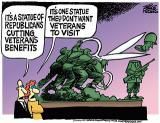A review of Agent Orange: "Collateral Damage" in Vietnam by Philip Jones Griffiths
Trolley Ltd. (Great Britain)
Hardback, 160 pages, with 100 b/w photographs
In this welcome and timely follow-up to his well-known 1971 classic Vietnam, Inc., photojournalist Phillip Jones Griffiths takes readers on a moving journey into the heart of darkness, shining a light on the pain that still lingers in Vietnam, whose residents are reminded every day of the war most of the world has tried to forget about.
As the title suggests, the photos and text of Agent Orange are focused specifically on the lasting damage done by the most famous of the various defoliants (nicknamed for the orange canisters it was transported and stored in) with which U.S. forces drenched the jungles of South Vietnam. Although "Agent Orange" was intended only as a tactical weapon – not meant to inflict physical damage on the enemy, only to deprive them of cover – it contained a byproduct of chlorine known as dioxin, one of the worst toxins known to man. A huge segment of the population of South Vietnam (along with some residents of Cambodia and many U.S. soldiers) was exposed to the poison during the war, whether it was rained directly onto their skin, inhaled during the spraying of large areas, or ingested in water or food that was exposed. (Unbelievably, the used orange storage barrels were also used for water, food and petroleum storage, and even as barbecue pits, causing further spread of the toxin.) Dioxin is a virtual "genetic time bomb" :once it has entered the body, it may cause any number of birth defects in the children of those exposed, ranging from stillbirth or infant death to mental retardation or physical deformity. Agent Orange is a devastating pictorial catalogue of these defects and more – the enduring legacy of dioxin poisoning in Vietnam. read more>>>
























No comments:
Post a Comment